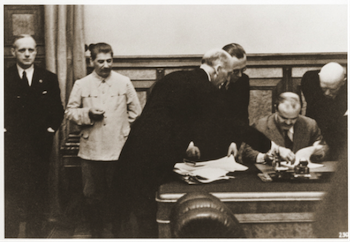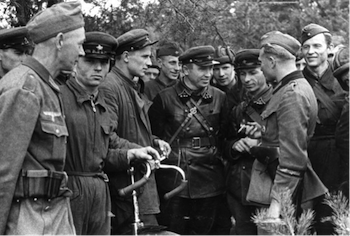

|
The Stalin-Hitler Pact  Molotov signs the Non-Aggression Pact The Soviet Union was the only foreign power to support the anti-fascist cause in Spain. Franco's victory in the Spanish Civil War increased Stalin's doubts about the commitment of the Western powers to the struggle against the Axis powers. The British and the French were set upon a course of appeasement. They had failed to act against the German occupation of the Rhineland in March 1936, against Hitler's annexation of Austria in March 1938, and the occupation of Czechoslovakia. It seemed to Stalin that the Western powers were intent on turning German aggression east, towards the Soviet Union. Sceptical about the British and the French, Stalin began sending signals to Hitler with a view to offering a deal of Soviet neutrality in the event of a European war. Hitler needed Soviet neutrality for his invasion of Poland. Aware that it would raise the price the Germans were prepared to pay for an agreement with Moscow, the Soviets continued to negotiate with the British and the French. But the Western powers were not serious about defending Poland and thought that war could still be avoided. They came to Moscow without a detailed plan for a joint operation or any real intention of agreeing to a military alliance with the Soviet Union. They suspected it of harbouring aggressive intentions towards Finland and the Baltic states that could push them into the German camp. The Poles would not agree to Soviet forces on their soil. So the talks broke down. On 23 August 1939 the Soviets signed a Pact of Non-Aggression with Hitler's Germany. There was a secret protocol to the pact, revealed only after 1945, according to which the states of Eastern Europe and the Baltic were divided into German and Soviet 'spheres of influence'. Finland, Estonia and Latvia were assigned to the Soviet sphere, along with eastern Poland and most of Lithuania. The Soviet Union would effectively reclaim the western territories of the Russian Empire. By remaining neutral in a war between two forces he considered hostile to the Soviet Union, the Western and the Fascist states, Stalin hoped to see them wipe each other out in a long and draining conflict that might spark revolutions in both camps. As he told the Politburo on 19 August: 'It is in the interests of the USSR that a war breaks out between the Reich and the capitalist Anglo-French bloc. Everything should be done so that it drags out as long as possible with the goal of weakening both sides.' For many Communists across the world, the Soviet-Nazi Pact was a huge ideological shock. The leading role of the Soviet Union in the struggle against fascism was one of the myths by which they had maintained their beliefs. Later they would try to justify the pact in tactical terms, arguing that the Soviet Union needed more time to prepare for war against Hitler's Germany. The argument is often heard today. But in fact at the time Stalin meant to stay out of the war for as long as possible. On Stalin's orders the Comintern instructed Communists to use the war to organize unrest inside their countries, as the Bolsheviks had done in 1917. War and revolution would go hand in hand.  Soviet and German Troops, Brest-Litovsk 1939 Assured of Soviet neutrality, Germany invaded western Poland on 1 September; two days later Britain and France declared war on Germany; and shortly afterwards the Red Army entered Poland from the east. The invading Soviet troops were accompanied by NKVD units to carry out arrests and executions: 15,000 Polish POWs and 7,000 other prisoners were shot by the NKVD in the Katyn Forest near Smolensk; and at least a million 'anti-Soviet elements' were deported from Poland and the Baltic lands. After the occupation of Poland, the Soviet Union began to pressure the Baltic states and Finland to accept territorial changes and Soviet bases on their soil. Estonia, Latvia and Lithuania gave in to the Soviet demands, signing pacts of 'defence and mutual assistance,' which allowed their occupation by the Red Army. But Finland proved less compliant, rejecting Soviet demands for army bases on its soil. The Soviets launched an invasion of Finland in November 1939. They were confident of victory after their military successes in Manchuria, Poland and the Baltic states. But the war in Finland went disastrously. Soviet troops were unprepared for winter fighting, and could not breach the solid Finnish defences. In four months 126,000 Soviet troops were killed and nearly 300,000 injured. In the end, Soviet reinforcements were able to break through the Finnish lines, but it was a costly victory, and Soviet weaknesses had been exposed. |
© 2014 Orlando Figes | All Rights Reserved